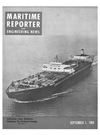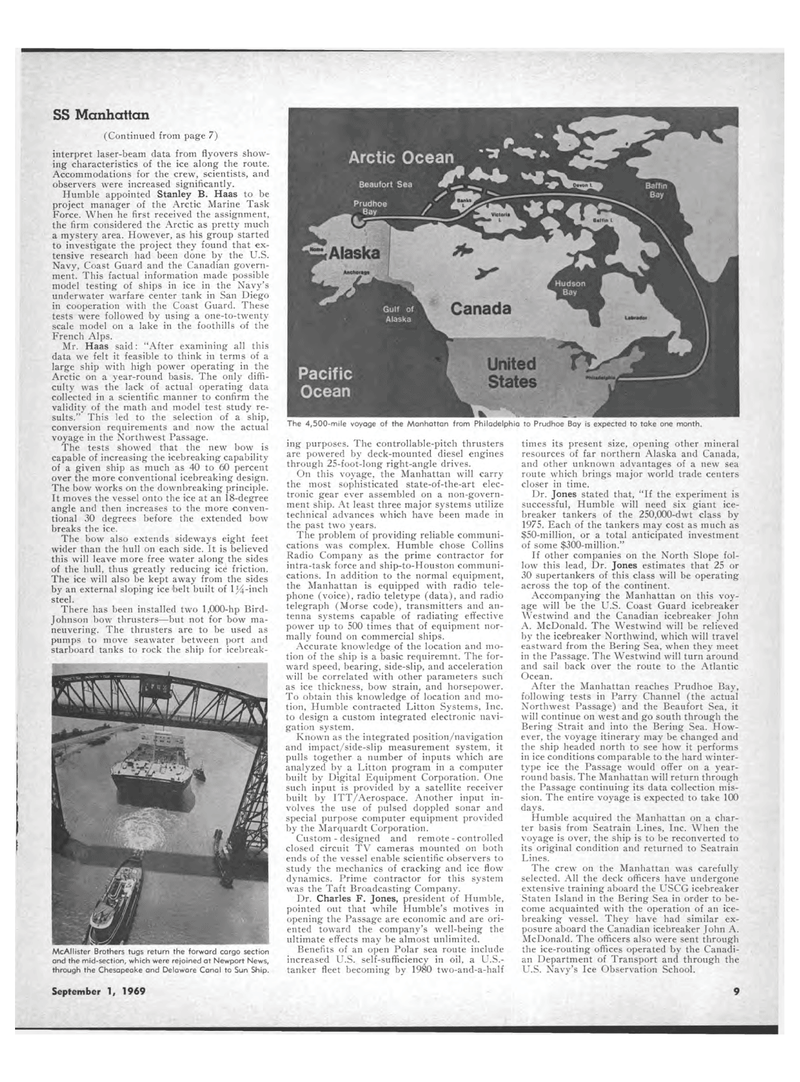
Page 7: of Maritime Reporter Magazine (September 1969)
Read this page in Pdf, Flash or Html5 edition of September 1969 Maritime Reporter Magazine
SS Manhattan (Continued from page 7) interpret laser-beam data from flyovers show-ing characteristics of the ice along the route. Accommodations for the crew, scientists, and observers were increased significantly. Humble appointed Stanley B. Haas to be project manager of the Arctic Marine Task Force. When he first received the assignment, the firm considered the Arctic as pretty much a mystery area. However, as his group started to investigate the project they found that ex-tensive research had been done by the U.S. Navy, Coast Guard and the Canadian govern-ment. This factual information made possible model testing of ships in ice in the Navy's underwater warfare center tank in San Diego in cooperation with the Coast Guard. These tests were followed by using a one-to-twenty scale model on a lake in the foothills of the French Alps. Mr. Haas said: "After examining all this data we felt it feasible to think in terms of a large ship with high power operating in the Arctic on a year-round basis. The only diffi-culty was the lack of actual operating data collected in a scientific manner to confirm the validity of the math and model test study re-sults." This led to the selection of a ship, conversion requirements and now the actual voyage in the Northwest Passage. The tests showed that the new bow is capable of increasing the icebreaking capability of a given ship as much as 40 to 60 percent over the more conventional icebreaking design. The bow works on the downbreaking principle. It moves the vessel onto the ice at an 18-degree angle and then increases to the more conven-tional 30 degrees before the extended bow breaks the ice. The bow also extends sideways eight feet wider than the hull on each side. It is believed this will leave more free water along the sides of the hull, thus greatly reducing ice friction. The ice will also be kept away from the sides by an external sloping ice 'belt built of 1 J^-inch steel. There has been installed two 1,000-hp Bird-Johnson bow thrusters?but not for bow ma-neuvering. The thrusters are to be used as pumps to move seawater between port and starboard tanks to rock the ship for icebreak-McAllister Brothers tugs return the forward cargo section and the mid-section, which were rejoined at Newport News, through the Chesapeake and Delaware Canal to Sun Ship. ing purposes. The controllable-pitch thrusters are powered by deck-mounted diesel engines through 25-foot-long right-angle drives. On this voyage, the Manhattan will carry the most sophisticated state-of-the-art elec-tronic gear ever assembled on a non-govern-ment ship. At least three major systems utilize technical advances which have been made in the past two years. The problem of providing reliable communi-cations was complex. Humble chose Collins Radio Company as the prime contractor for intra-task force and ship-to-Houston communi-cations. In addition to the normal equipment, the Manhattan is equipped with radio tele-phone (voice), radio teletype (data), and radio telegraph (Morse code), transmitters and an-tenna systems capable of radiating effective power up to 500 times that of equipment nor-mally found on commercial ships. Accurate knowledge of the location and mo-tion of the ship is a basic requiremnt. The for-ward speed, bearing, side-slip, and acceleration will be correlated with other parameters such as ice thickness, bow strain, and horsepower. To obtain this knowledge of location and mo-tion, Humble contracted Litton Systems, Inc. to design a custom integrated electronic navi-gation system. Known as the integrated position/navigation and impact/side-slip measurement system, it pulls together a number of inputs which are analyzed by a Litton program in a computer built by Digital Equipment Corporation. One such input is provided by a satellite receiver built by ITT/Aerospace. Another input in-volves the use of pulsed doppled sonar and special purpose computer equipment provided by the Marquardt Corporation. Custom-designed and remote-controlled closed circuit TV cameras mounted on both ends of the vessel enable scientific observers to study the mechanics of cracking and ice flow dynamics. Prime contractor for this system was the Taft Broadcasting Company. Dr. Charles F. Jones, president of Humble, pointed out that while Humble's motives in opening the Passage are economic and are ori-ented toward the company's well-being the ultimate effects may be almost unlimited. Benefits of an open Polar sea route include increased U.S. self-sufficiency in oil, a U.S.-tanker fleet becoming by 1980 two-and-a-half times its present size, opening other mineral resources of far northern Alaska and Canada, and other unknown advantages of a new sea route which brings major world trade centers closer in time. Dr. Jones stated that, "If the experiment is successful, Humble will need six giant ice-breaker tankers of the 250,000-dwt class by 1975. Each of the tankers may cost as much as $50-million, or a total anticipated investment of some $300-million." If other companies on the North Slope fol-low this lead, Dr. Jones estimates that 25 or 30 supertankers of this class will be operating across the top of the continent. Accompanying the Manhattan on this voy-age will be the U.S. Coast Guard icebreaker Westwind and the Canadian icebreaker John A. McDonald. The Westwind will be relieved by the icebreaker Northwind, which will travel eastward from the Bering Sea, when they meet in the Passage. The Westwind will turn around and sail back over the route to the Atlantic Ocean. After the Manhattan reaches Prudhoe Bay, following tests in Parry Channel (the actual Northwest Passage) and the Beaufort Sea, it will continue on west and go south through the Bering Strait and into the Bering Sea. How-ever, the voyage itinerary may be changed and the ship headed north to see how it performs in ice conditions comparable to the hard winter-type ice the Passage would offer on a year-round basis. The Manhattan will return through the Passage continuing its data collection mis-sion. The entire voyage is expected to take 100 days. Humble acquired the Manhattan on a char-ter basis from Seatrain Lines, Inc. When the voyage is over, the ship is to be reconverted to its original condition and returned to Seatrain Lines. The crew on the Manhattan was carefully selected. All the deck officers have undergone extensive training aboard the USCG icebreaker Staten Island in the Bering Sea in order to be-come acquainted with the operation of an ice-breaking vessel. They have had similar ex-posure aboard the Canadian icebreaker John A. McDonald. The officers also were sent through the ice-routing offices operated by the Canadi-an Department of Transport and through the U.S. Navy's Ice Observation School. September 1, 1969 9

 6
6

 8
8
